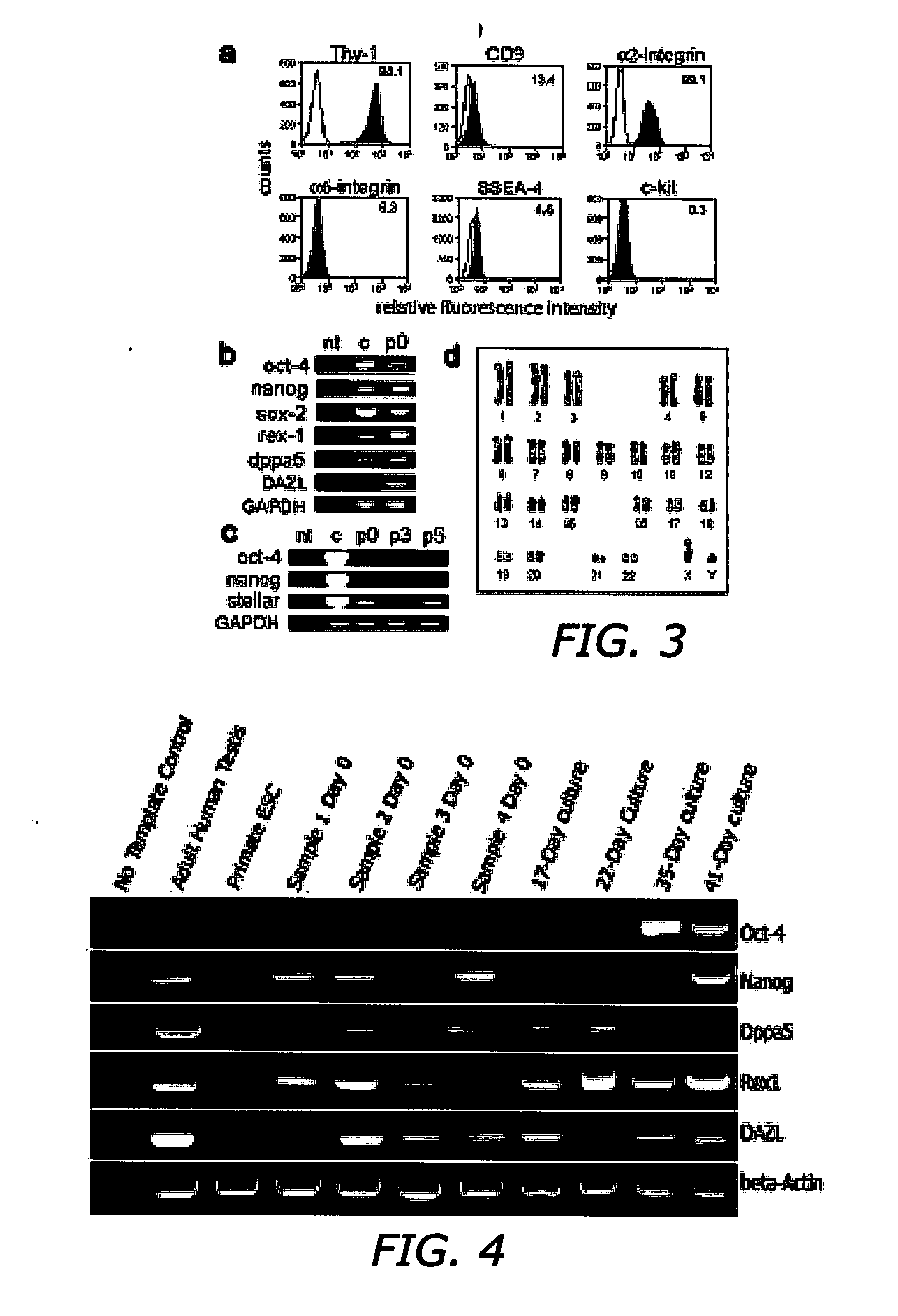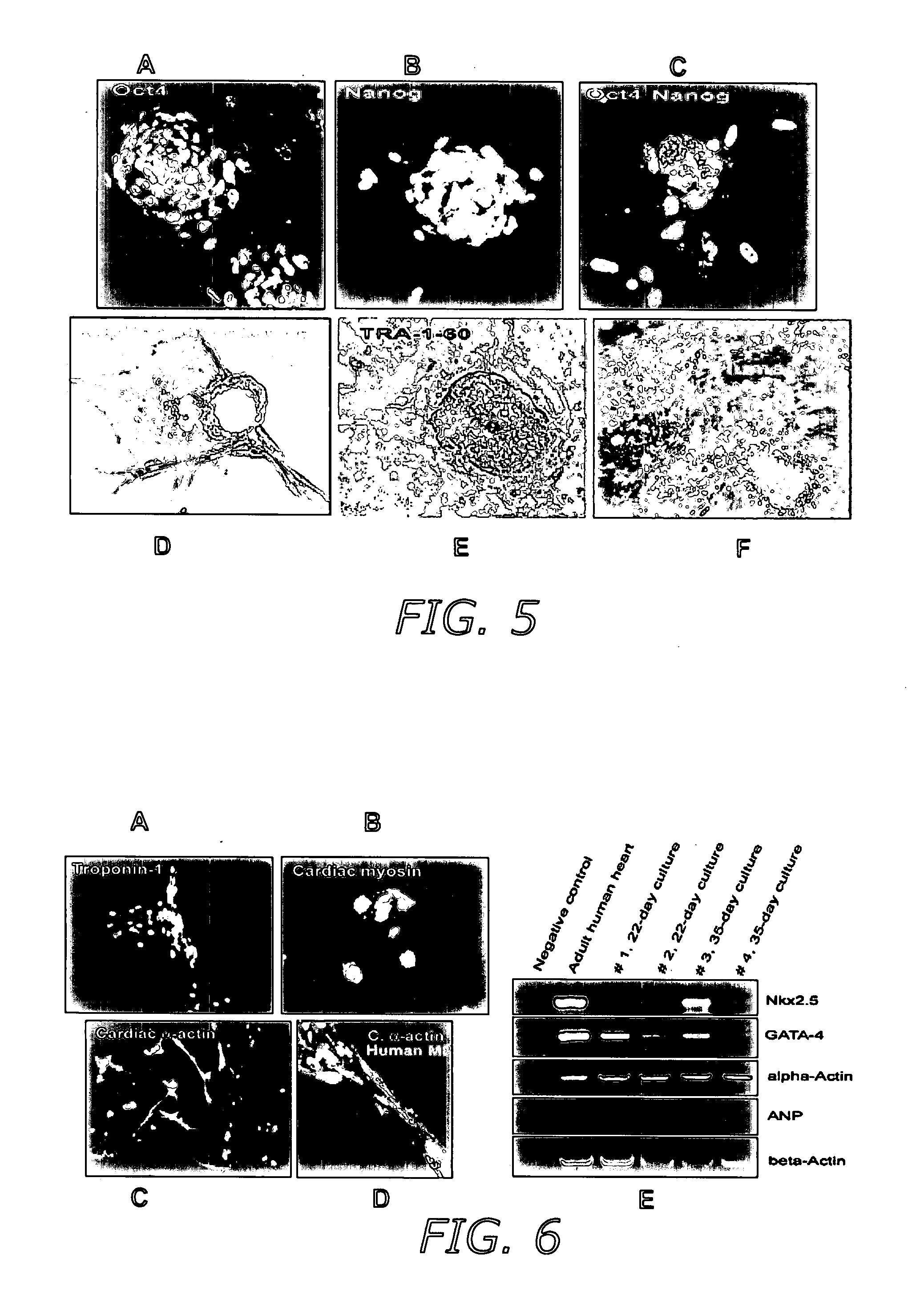Reprogramming of adult human testicular stem cells to pluripotent germ-line stem cells
a technology of adult human testicular stem cells and germ-line stem cells, applied in the field of therapeutically reprogrammed cells, can solve the problems of genome destruction, reduced cell differentiation ability or apoptosis, and limited types in number
- Summary
- Abstract
- Description
- Claims
- Application Information
AI Technical Summary
Problems solved by technology
Method used
Image
Examples
example 1
Therapeutic Reprogramming Culture Medium
[0082] A cell culture medium for therapeutically reprogramming human stem cells is provided wherein the cell culture medium comprises a cell culture growth medium base; a plurality of vitamins and minerals and a plurality of cell growth and maturation factors. In one embodiment of the present invention, the cell culture medium is serum free.
[0083] The therapeutic reprogramming cell culture medium comprises a plurality of cell growth and maturation factors selected from the group consisting of recombinant human epidermal growth factor, recombinant human fibroblast growth factor 2, recombinant human glial cell derived neurotrophic factor and human leukemia inhibitory factor. The recombinant human epidermal growth factor is present at a concentration of between approximately 10 ng / mL and approximately 40 ng / mL, preferably approximately 20 ng / mL. The recombinant human fibroblast growth factor 2 is present at a concentration of between approximat...
example 2
Therapeutic Reprogramming of Testicular Cells
[0084] Adult human testes were obtained from patients between 23-52 years of age. These patients were admitted to a clinic for reasons unrelated to cancerous conditions. Their medical history and condition are not to be disclosed in respect to patient's privacy.
[0085] Testicular samples were washed 5 times in cold phosphate-buffered saline (PBS) containing 0.01% EDTA. Seminiferous tubules were dissected, minced, and digested with collagenase / DNase. Dissociated cells were centrifuged and re-suspended in the serum-free PM-10™ medium containing a stem cell medium base, non-essential amino acids, and 19 cell growth-promoting and reprogramming factors, including GDNF. Blood and somatic cells were discarded after overnight differential adhesion. Stem cells in suspension were collected and plated onto culture dishes coated with gelatin, fibronectin, mouse feeder cells, or low-adhesive surface. In average, about 150 million cells per testis wer...
example 3
Phenotypic Characterization of Therapeutically Reprogrammed Cells
[0088] Several markers found on adult stem cells were highly expressed on the surface of AHTSCs, including Thy-1 and α2-integrin as well as a moderate level of CD-9, α6-integrin and SSEA-4, but not c-Kit (FIG. 3A). Moreover, a weak expression of the major histocompatibility complex, MHC-I, was observed, whereas MHC-II and several hematopoietic stem cell markers were non-detectable. The gene (mRNA) expression profile for the AHTSC population taken at day 6 post-reprogramming (passage 0) showed that the cells expressed pluripotent markers, Oct-4, Nanog, Sox-2, Rex-1 and Dppa5 (FIG. 3B). The origin of lineage was identified by the germ cell markers, DAZL and Stellar (FIG. 3B-C). Cells used for transplantation expressed the pluripotent markers, Oct-4 and Nanog (FIG. 2D-E) and were diploid without chromosomal aberrations as determined by karyotype analysis (FIG. 3D).
[0089] The expression of Oct-4 is a signature of pluripo...
PUM
| Property | Measurement | Unit |
|---|---|---|
| size | aaaaa | aaaaa |
| concentration | aaaaa | aaaaa |
| concentration | aaaaa | aaaaa |
Abstract
Description
Claims
Application Information
 Login to View More
Login to View More - R&D
- Intellectual Property
- Life Sciences
- Materials
- Tech Scout
- Unparalleled Data Quality
- Higher Quality Content
- 60% Fewer Hallucinations
Browse by: Latest US Patents, China's latest patents, Technical Efficacy Thesaurus, Application Domain, Technology Topic, Popular Technical Reports.
© 2025 PatSnap. All rights reserved.Legal|Privacy policy|Modern Slavery Act Transparency Statement|Sitemap|About US| Contact US: help@patsnap.com



